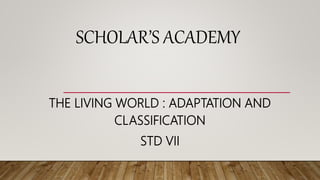
Chapter 1 the living world adaptation and classification
- 1. SCHOLAR’S ACADEMY THE LIVING WORLD : ADAPTATION AND CLASSIFICATION STD VII
- 4. SMALL PLANTS BIG TREES
- 9. What is adaptation? • Adaptation describes how a plant or animal is able to survive in various environmental conditions. • Well adapted organisms can cope with the different aspects of their environment. For example, the temperature.
- 10. Gradual changes occur in the body and also in the behavior of organisms which helps them to adjust to their surroundings. Such changes are called adaptation. Define Adaptation
- 17. CONE
- 33. Observe the bodies of the frog , duck and tortoise. Text book page no 5 1. Of what use are their legs to these animals? A. All the three animals i.e frog, duck and tortoise use their legs for locomotion and swimming. 2. What helps frogs to breathe underwater? A. When in water frogs breathe with the help of skin.
- 34. 3. Of what use are the long hind legs of the frog? A. When on land frog uses its hind legs for jumping. When is water the same legs are used for swimming as oars. 4. Why doesn’t a duck get wet in water? A. Water flows off from the waxy layer of feathers thus duck does not get wet even in water.
- 57. ADAPTATION FOR BLENDING WITH THE SURROUNDINGS • Many animals use camouflage, which means they are able to blend in with the color, pattern, or texture of their surroundings so they are not detected by a predator. • Camouflage can also come in handy for a predator when it wants to surprise its prey.
- 59. Snow Fox Peringuey's viper sliding through sand
- 61. Charles Robert Darwin • He was an English biologist, best known for his contributions to the science of evolution. • He has studied numerous types of Plants and Animal. • He suggested that only those organisms are likely to survive which can best adapt themselves to a changing environment. • This theory was known as Survival of the fittest. This is Darwin ‘s First principle. • If an organism is born with a new beneficial characteristic and is able to survive , so this change is preserved in the next generation. • So this was Darwin’s second principle and is called as Theory of Natural Selection
- 63. Which are the criteria used for the classification of plant and animals? Plant are classified according to Height, Shape of Period of life cycle, whether they are flowering plants non flowering plants and their habitat. Animals are classified according to cell structure, vertebral column, method of reproduction and habitat.
- 64. How are organism Classified? • Animals and Plants are classified according to its characteristic. • For this detail study of these organisms is done. • Based on similarities and differences the organisms are classified into groups and sub groups. • A hierarchy is formed depending on these features. • In this way the organism are placed in suitable groups and classification is achieved.
- 65. Classification of living organisms • It is necessary to classify the living things because it is difficult to study and remember all the diverse organisms in this world. • Different Scientists have used different criteria and gave the method of classification
- 66. • Hierarchy of classification : Classification starts with Kingdom Animalia or Kingdom Plantae. • Then depending upon basic similarities and differences their further groups and subgroups are formed. • This is known as Hierarchy of classification. • Kingdom , • Phylum/division • Class • Order • Family • Genus • Species are the sequences of the classification system
- 68. Binomial nomenclature by Carl Linnaeus • Binomial Nomenclature is used to identify each organism. This method was suggested by Carl Linnaeus. • Every living organism has given uniform name throughout the world. • This is called the scientific name. Scientific name consist of two part – The first part is genus and second part is species. • As per the guidelines of International Code of Nomenclature, every organism has a binomial name.
- 69. Only organism belonging to the same species can produce an offspring. All the organism belonging to the same species may have difference in colour, height , habitats and habits but still they can reproduce among themselves and for offspring like themselves.
- 71. THANK YOU
